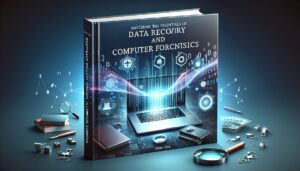In the modern information-rich world, data is increasingly recognized as a valuable asset: driving decision-making processes, instigating insights, and continuously shaping an organization’s strategy. But, underscoring the importance and omnipresent nature of data is the ever-emerging challenge of data loss and threats to data integrity. This brings into sharp focus the cruciality of data recovery and computer forensics for those operating in the rapidly transforming cyber landscape.
Why is Data Recovery and Computer Forensics Important?
For organizations and technical professionals alike, understanding data recovery and computer forensics is not a merely ‘handy’ skillset to have, but an integral part of safeguarding their pivotal digital presence. The tools and techniques surrounding this field remain decidedly hidden ‘behind the cyber curtain’—leaving them inaccessible to many ostensibly savvy, technically-informed individuals.
Indeed, data loss can manifest itself in numerous ways such as human error, decidedly malicious cyber-attacks or even physical damage to hardware— amongst others. Comprehending the means to retrieve lost data or investigate incidents addressing data breaches thus fortifies an organization’s resilient operations.
Data Recovery: Dealing with Data Loss
Data Recovery primarily refers to processes and tools involved in reclaiming data that has either been lost, mistakenly deleted or blemished as a result of a technical glitch or malfunction. Sound data recovery can be accomplished with the use of advanced software or indeed, the hot extraction of physical components through specialized practices.
When dealing with data loss, it is crucial to suspend use of the device (on which the data was originally stored) to minimize interference with potentially ‘at-risk’ data beneath the surfeit of complex file structures and formats. Using specialized software is a go-to method to recoup irretrievable data, but identification of the appropriate software is unconventionally complex— with prime considerations being the specific operating systems, APIs, drivers, hardware, and file systems, as well as the nature of data loss.
Before investing heavily in commercial software, a slice of advice for individuals sailing in the treacherous waters of ‘data loss’ could be testing readily-available open-source data recovery tools, available with extensive specific features to aid different data loss situations. Commercial-grade alternatives are invariably so expensive as they sporadically provide capabilities to recuperate data from advanced hardware or centuries-old legacy systems.
Computer Forensics: Uncovering Traces
Regarded as an extended arm of cybersecurity, computer forensics delves into the analysis and reporting of computing artifacts under the guise of investigating félonious actions or aiding in legal arbitrations involving compute technology. It essentially involves identifying, preserving, extracting, analyzing, and presenting computing-related evidence.
While not always visible on the facade, digital footprints and metadata can be incredibly telling of the actions taken on a specific device. Computer forensics exploits the inherently chronological nature of digital actions and retraces the sequence of events leading, during and following cyber semblance.
Computer forensics utilizes advanced tools to recover deleted files, analyze caches, decipher encrypted data, and investigate traces of unauthorized utilization of computer applications, among other organic digital dimples.
Conclusion: A leap Towards Cyber Readiness
In forging an understanding of data recovery or computer forensics, technical gabble verges on discernible patter for those looking to elevate their cybersecurity plot. Individuals who embark on upskilling in these critical technical fields align themselves with elevated-level commands, broadening their toolbox of counteractive mechanisms, and amplifying their capacity to respond to intensive cyber challenges promptly.
Being ‘behind the cyber curtain’ equips organizations and individuals with data-centric vivacity whilst traversing the elusively techno-centric, data-dubbed business ecosystems of today.



